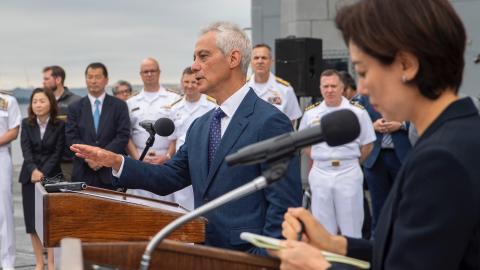US Ambassador to Japan Rahm Emanuel has a reputation for getting what he wants. As a former White House staffer and politician who operated at the highest echelons of American politics, he persistently pushed through policies.
Now, as the top American diplomat in Tokyo, he managed to help guide Prime Minister Fumio Kishida and President Joe Biden toward supporting the expanded maintenance and repairs of U.S. ships and aircraft in Japanese facilities. A newly established U.S.-Japan Forum on Defense Industrial Cooperation, Acquisition and Sustainment will convene in June to iron out the details and identify areas for better Japanese and U.S. industrial partnership.
As policymakers set the agenda for the DICAS meeting, they may be tempted to rally around marquee codevelopment programs such as the so-called Glide Phase Interceptor to counter hypersonic missiles. While an important joint project, it is only one of many potential opportunities. Similar approaches were tried by the alliance in the past and lost steam. For DICAS to succeed, it will need to swiftly meet the operational demands facing defense forces and build momentum by getting some quick wins.
Most importantly, DICAS must respond to integrated Japan-U.S. operational demands. To start, the forum could solicit pressing operational needs for alliance operations involving the Japan Joint Staff Office and the U.S. Indo-Pacific Command. After prioritizing a combined list of solutions that can be quickly implemented (likely focusing on joint sustainment, networking and decision support tools), DICAS could recommend to the Japanese Ministry of Defense and the U.S. Office of the Secretary of Defense that these solutions be funded in their upcoming budgets. As the new Japan Joint Operations Command is established, it could contribute to this continuous process.
Infrastructure, logistics and sustainment should certainly be atop the list of DICAS initiatives.
To enhance the operational readiness of their forward-deployed ships and aircraft, U.S. forces could increase the amount of repair and maintenance done by Japanese commercial facilities. However, instead of Japan merely providing services for U.S. forces, DICAS could promote more integrated operations within the alliance.
Linking fuel storage tanks at Japanese and U.S. bases would improve resilience, while joint fuel contracts for nearby military facilities could save costs. Additionally, as Japan undertakes a major initiative to construct defensive bunkers and hardened facilities, the United States could also use the same contractors to economically build some of its own.
Also, by aligning supply chain standards and adopting federated supply and logistics tools, the two countries could streamline the timely transfer of necessary items through the acquisition and cross-servicing agreement and enhance the readiness of their forces. Most of these initiatives are low-cost and can be implemented within a year.
Fielding affordable long-range weapons is another area ripe for cooperation. Japan is seeking to develop and acquire such strike systems both domestically and from the United States, but they are expensive and are being delivered at modest rates. Similarly, the United States faces challenges due to inadequate numbers of needed weapons like Tomahawk cruise missiles and long-range anti-ship missiles. As the conflict in Ukraine has shown and numerous studies have indicated, a conflict with China could necessitate tens to hundreds of thousands of appropriate munitions — far more than what Japan or the U.S. currently have in their inventories.
DICAS could diversify the alliance’s strike-capability portfolio by developing and acquiring complementary low-cost options, such as the Powered Joint Direct Attack Munition, that can be manufactured en masse. Another example is the Pentagon’s Replicator initiative (a program focused on fielding thousands of cheap, smart and autonomous attack drones and other systems to overwhelm an enemy's defenses), which aims to accelerate this effort at scale by next summer.
Given that many of these systems will need to operate in the Western Pacific, the Pentagon should discuss deployment options with planners in Tokyo and others in the DICAS forum. They should also invite The Japanese Defense Ministry's soon-to-be established technology research center to help guide the coproduction and future codevelopment of Replicator capabilities with the U.S. military's Defense Innovation Unit, which focuses on accelerating the adoption of commercial and dual-use technologies.
As the former White House chief of staff under Barack Obama and mayor of Chicago, Emanuel knows that simply declaring a policy is not enough; you have to deliver results. Japan and the United States face significant security challenges and must closely collaborate to pool and optimize their resources. The announced launch of DICAS and the expanded maintenance of U.S. ships and aircraft in Japan should be just the beginning of a deeper alliance approach to address urgent defense needs.
For DICAS to reach its potential, it will need to resist the alliance’s tendency to concentrate on a small number of slowly gestating programs and instead develop a forum that allows it to rapidly integrate, adapt and field capabilities at scale.
Read the full article at the Japan Times.




















